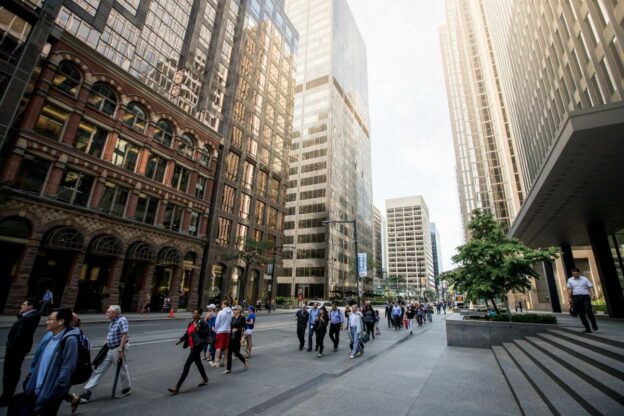Discover Toronto’s Financial District—home to Canada’s Big Five banks, the Toronto Stock Exchange, and global corporations. Learn why Bay Street is the country’s financial hub.
Toronto’s Financial District is the beating heart of Canada’s economy. Located in the downtown core, it is home to the country’s largest banks, global financial firms, corporate headquarters, law offices, and the Toronto Stock Exchange (TSX).
For decades, this area has been recognized as the center of business, finance, and investment in Canada.
Contents
Location and Boundaries
The Toronto Financial District is primarily concentrated around Bay Street, which is often compared to Wall Street in New York City.
-
Core streets: Bay Street, King Street West, Front Street, and Adelaide Street.
-
Transit access: Toronto’s Union Station is nearby, making the district easily accessible through the city’s subway and regional GO Transit system.
-
Landmarks: CN Tower, Union Station, and the PATH underground network.
Key Features of the Toronto Financial District
1. Headquarters of Canada’s Big Five Banks
The Financial District houses the main offices of:
-
Royal Bank of Canada (RBC)
-
Toronto-Dominion Bank (TD)
-
Bank of Montreal (BMO)
-
Scotiabank
-
Canadian Imperial Bank of Commerce (CIBC)
These institutions dominate the Canadian banking sector and have major global influence.
2. Toronto Stock Exchange (TSX)
The Toronto Stock Exchange (TSX), located on Bay Street, is one of the largest stock markets in the world.
-
Global ranking: consistently in the top 10 by market capitalization.
-
Specialty: leading in natural resources, mining, and energy companies.
-
Role: a critical hub for both Canadian and international investors.
3. Corporate and Legal Headquarters
Beyond banking, the Financial District is home to:
-
Major Canadian law firms.
-
Accounting giants like Deloitte, PwC, EY, and KPMG.
-
Corporate headquarters of energy, telecom, and tech companies.
4. Architecture and Skyscrapers
The district’s skyline is dominated by Canada’s tallest and most iconic office towers:
-
First Canadian Place (home to BMO, tallest office tower in Canada).
-
TD Canada Trust Tower.
-
Scotiabank Plaza.
-
CIBC Square.
These skyscrapers define Toronto’s downtown landscape and symbolize its economic power.
5. The PATH Underground Network
Toronto’s Financial District is connected by PATH, the world’s largest underground shopping and pedestrian network.
-
Length: over 30 km of walkways.
-
Shops & services: more than 1,200 shops, restaurants, and services.
-
Function: allows workers and visitors to move comfortably during harsh winters.
Why the Toronto Financial District Matters
-
Economic Powerhouse – It generates a significant portion of Canada’s GDP.
-
Talent Hub – Attracts professionals in finance, law, technology, and consulting.
-
Global Influence – Toronto ranks among the world’s top financial centers.
-
Innovation – Growing fintech and AI industries are reshaping the financial core.
FAQ
1. What is the Financial District in Toronto?
It is the central business hub of Toronto, home to Canada’s largest banks, the Toronto Stock Exchange, and many corporate offices.
2. Why is Bay Street important?
Bay Street is Canada’s equivalent of Wall Street, housing the headquarters of the Big Five Canadian banks and many investment firms.
3. Which companies are located in the Financial District?
Primarily banks, insurance companies, law firms, consulting firms, and multinational corporations.
4. Is the Toronto Financial District only about banking?
No. While finance dominates, the area also hosts legal, consulting, technology, and real estate companies.
5. What is PATH in Toronto?
PATH is a 30 km underground pedestrian system connecting offices, malls, transit stations, and services in downtown Toronto.
Conclusion
The Toronto Financial District is more than just skyscrapers—it is the engine of Canada’s economy. With the Big Five banks, Toronto Stock Exchange, multinational corporations, and cutting-edge fintech firms, the district symbolizes Canada’s strength in global finance.
For professionals, investors, and businesses, Toronto’s Financial District offers unmatched opportunity, prestige, and influence.
